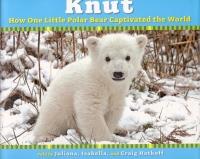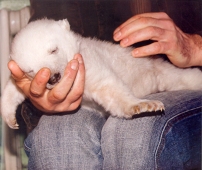| ________________
CM . . .
. Volume XV Number 10. . . .January 9, 2009 
 |
Knut: How One Little Polar Bear Captivated the World.
Juliana, Isabella and Craig Hatkoff & Gerald R. Uhlich. Photographs by Zoo Berlin.
New York, NY: Scholastic (Distributed in Canada by Scholastic Canada), 2008.
32 pp., hardcover, $19.99.
ISBN 978-0-545-04716-6.
Subject Headings:
Knut (Polar bear)-Juvenile literature.
Polar bear-Germany-Berlin-Biography-Juvenile literature.
Zoo animals-Germany-Berlin-Biography-Juvenile literature.
Grades 1-4 / Ages 6-9.
Review by Shari Klassen.
***½ /4
|
| |
|

excerpt:
On a warm day in March, when Knut was three months old, Thomas led him outdoors for the first time. Knut excitedly explored every corner of the small play area, but he never strayed far from Thomas. In the sandbox, Knut made two discoveries: one, that sand is not good to eat, and, two, that sand is great fun to roll around in.
Knut: How One Little Polar Bear Captivated the World is the real-life story of a young polar bear cub born in captivity on December 5, 2006, at the Zoo Berlin in Germany. The tale –– written by Craig and Isabella Hatkoff (of Owen & Mzee fame) and now joined by Juliana Hatkoff and Dr. Gerald R. Uhlich –– takes the reader through the first few months of little Knut's (pronounced K'-noot) life –– from his birth and rejection by his polar bear mother, to his adoption by chief bear keeper Thomas Döörflein, to his steady growth into a strong and playful young bear. It is not clear which sections are written by which of the four individuals credited, suggesting that the text was written collaboratively. The language used is simple and yet captivating to both child and adult readers alike, as small nuances in the phrases –– such as "With his bright black eyes, he look around at everything" –– capture the wonder with which Knut explores his new world. With each passing page, the reader grows more and more proud of Knut and his successes. It is almost as if Knut has become the reader's child-bear as much as he has become that to Thomas. Readers become privileged to special information about Knut's daily steps, and, therefore, personal information about the life lived by his caretaker for the first few months of Knut's existence.
The tiny bear became the center of Thomas's life. But he missed his own family at home… They missed him, too. But they felt very proud of him. They visited Thomas every day. And on Christmas Eve, they arrived with a special dinner, presents, and even a beautifully decorated tree…
 The candid photographs of Knut and Thomas are featured as prominently, if not more so, as the words of the story. Each photograph is accompanied by a caption that contains factual information about polar bears as related to the conditions set up for Knut at the zoo (e.g., "Snow dens in the wild get very warm –– up to 95 degrees Fahrenheit –– so Thomas was careful to keep Knut toasty."). The photographs vividly capture both Knut's personality as being playful, vivacious, loving, curious, and mischievous, as well as the deep bond between Knut and Thomas and the ease with which they seem to relate to each other; and the stories and events as they progress. The photos make the reality of the story come alive for the reader and, therefore, are the most important feature of this book. The book, itself, is cleanly designed with bright colours that complement the photographs, making them stand out, and they draw the reader's focus to the content rather than to the design, itself. The candid photographs of Knut and Thomas are featured as prominently, if not more so, as the words of the story. Each photograph is accompanied by a caption that contains factual information about polar bears as related to the conditions set up for Knut at the zoo (e.g., "Snow dens in the wild get very warm –– up to 95 degrees Fahrenheit –– so Thomas was careful to keep Knut toasty."). The photographs vividly capture both Knut's personality as being playful, vivacious, loving, curious, and mischievous, as well as the deep bond between Knut and Thomas and the ease with which they seem to relate to each other; and the stories and events as they progress. The photos make the reality of the story come alive for the reader and, therefore, are the most important feature of this book. The book, itself, is cleanly designed with bright colours that complement the photographs, making them stand out, and they draw the reader's focus to the content rather than to the design, itself.
Before the story begins, a German word pronunciation guide is given to allow the English-speaking reader to be familiar with the foreign terms when they appear in the context of the story. This approach allows the reader to focus on the story instead of on the words. At the end of the story about Knut, the authors provide a section of factual information about the appearance, food, family life, and habitat of polar bears, included a striking photograph of the animals in their natural environment. Following this, an aerial photograph of the Arctic Ocean shows the shrinking sea ice, while an accompanying body of text explains the dangers of global warming to the existence of polar bears and offers a list of practical ways to help fight global warming. This body of information provides a very powerful framework within which the sharing of Knut's story with the world is important: knowledge and familiarity with such knowledge can affect change to save the polar bears from extinction.
Through Knut's simple story and joyful pictures, readers grow to love this little bear and develop a deep respect for his foster "mother," Thomas. Within the tale, itself, no anti-global warming message is present. It is simply the heart-warming story of a beautiful connection between a man and a bear, a connection that saved this little bear's life. However, within the framework mentioned above, this story's purpose is clear and necessary in a world that is being increasingly affected by the results of global warming. Knut has the power to cause its readers to seriously consider what they can do so that there can be more stories of triumph like this in the future. The authors state it best in their forward:
In a world where polar bear habitats are rapidly shrinking, Knut reminds us just what we are at risk of losing. He makes it clear that we all breathe the same air at one point or another and encourages us to respect all habitats. In telling Knut's story, perhaps his grandchildren might just be remembered as the descendants of the little cub who made a difference in the world.
Highly Recommended.
Shari Klassen is an early-years teacher in Winnipeg, MB.

To comment
on this title or this review, send mail to cm@umanitoba.ca.
Copyright © the Manitoba Library Association. Reproduction for personal
use is permitted only if this copyright notice is maintained. Any
other reproduction is prohibited without permission.
NEXT REVIEW |
TABLE OF CONTENTS FOR THIS ISSUE
- January 9, 2009.
AUTHORS |
TITLES |
MEDIA REVIEWS |
PROFILES |
BACK ISSUES |
SEARCH |
CMARCHIVE |
HOME |

 The candid photographs of Knut and Thomas are featured as prominently, if not more so, as the words of the story. Each photograph is accompanied by a caption that contains factual information about polar bears as related to the conditions set up for Knut at the zoo (e.g., "Snow dens in the wild get very warm –– up to 95 degrees Fahrenheit –– so Thomas was careful to keep Knut toasty."). The photographs vividly capture both Knut's personality as being playful, vivacious, loving, curious, and mischievous, as well as the deep bond between Knut and Thomas and the ease with which they seem to relate to each other; and the stories and events as they progress. The photos make the reality of the story come alive for the reader and, therefore, are the most important feature of this book. The book, itself, is cleanly designed with bright colours that complement the photographs, making them stand out, and they draw the reader's focus to the content rather than to the design, itself.
The candid photographs of Knut and Thomas are featured as prominently, if not more so, as the words of the story. Each photograph is accompanied by a caption that contains factual information about polar bears as related to the conditions set up for Knut at the zoo (e.g., "Snow dens in the wild get very warm –– up to 95 degrees Fahrenheit –– so Thomas was careful to keep Knut toasty."). The photographs vividly capture both Knut's personality as being playful, vivacious, loving, curious, and mischievous, as well as the deep bond between Knut and Thomas and the ease with which they seem to relate to each other; and the stories and events as they progress. The photos make the reality of the story come alive for the reader and, therefore, are the most important feature of this book. The book, itself, is cleanly designed with bright colours that complement the photographs, making them stand out, and they draw the reader's focus to the content rather than to the design, itself.